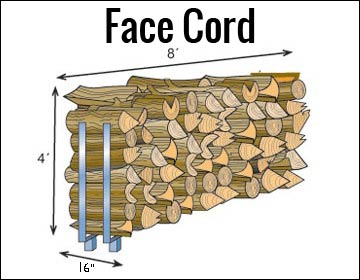Purchasing
When you are phoning around to compare firewood and prices, make sure you are comparing apples to apples! Firewood quality varies widely because of species, how it is cut, split, handled, stored and measured before it gets delivered to you. Look for:
- A good hardwood mix – no softwood, poplar or weedy species such as Manitoba maple
- Seasoned or at least partly seasoned – buying wood in the spring or summer will allow you time to further season the wood at home for best results
- Uniform lengths and well split
- Screened so you are not paying for a lot of bark, wood chips and dirt
Measuring
 In Canada, a cord is a legal unit of measurement defined by the Weights and Measures Regulations as 128 cubic feet. This is a stack of wood 4 feet x 8 feet x 4 feet. Locally, this is often called a “cubic cord” or “bush cord”.
In Canada, a cord is a legal unit of measurement defined by the Weights and Measures Regulations as 128 cubic feet. This is a stack of wood 4 feet x 8 feet x 4 feet. Locally, this is often called a “cubic cord” or “bush cord”.
However, most cut / split firewood businesses sell wood by the face cord. This is because usually firewood is cut in 16 inch lengths for use in wood stoves, fireplaces and indoor furnaces. If you make a pile of 16 inch lengths that is 4 feet high and 8 feet long you will have a face cord.
Seasoning and Storing
There is nothing more frustrating than wood that won’t light or does not burn well. You get tons of smoke and no heat. Your firewood needs to be dry or “seasoned” for you to be happy with it. We season our wood by exposing it to sun and wind and protecting it from ground moisture. When it gets to your house, you need to store it properly for best results. Here are some storing tips:
- Choose a location that gets plenty of air circulation, is protected from the rain and is easily accessible during the winter so you can easily bring the wood from your storage to your wood burning appliance – an open shed, shelter or porch is best.
- Stack the wood. Make sure it is not too high or unstable for safety reasons and position stacks close enough together so that children or pets cannot climb between them or around them.
- Leave a space between the wall and stacks of wood to increase the air flow.
- Reduce exposure to ground moisture by putting something between the ground and the wood such as a tarp, wooden pallet or drainable gravel or rock
- If your wood is stored outdoors, bring some wood inside ahead of time to “thaw”. It is much easier to light wood that is at room temperature.
Safe Burning

There is nothing like a cozy wood fire on a cold winter night. However, like every heating source, there are precautions that must be taken with firewood to keep your family safe:
- Only burn seasoned firewood to prevent excessive build up of creosote in your chimney. Creosote can cause chimney fires.
- Burn firewood and only firewood. Construction scraps, painted wood or other treated wood release dangerous chemicals that impact your indoor air quality and are terrible for the environment.
- Burn the fire hot. Keep the damper open completely when you are starting the fire and then turn it down when the fire gets going well. Once hot coals are established, you can turn it right down to conserve wood but it will still burn hot. A hot fire prevents creosote from developing in your chimney which can cause chimney fires. It also creates fewer emissions which is better for the environment.
- Get your chimney cleaned and your appliance checked regularly by a professional to ensure safety and efficiency.
- Install carbon monoxide detectors and smoke detectors and ensure they are in working order

